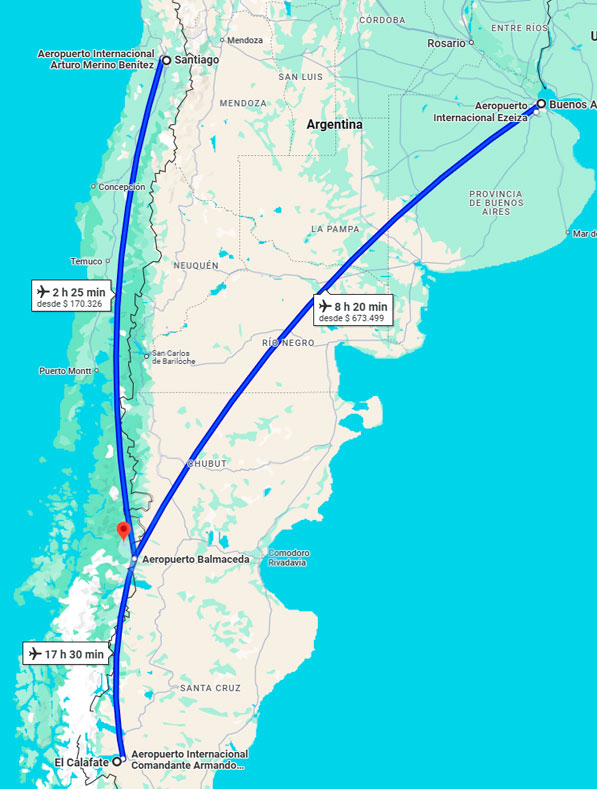South America
Welcome Kit
Chile
Aysén Region
The Aysén Region in Chilean Patagonia features fjords, glaciers, rivers, and mountains. It lies in a transition zone between temperate rainforests and the Patagonian steppe, offering wild and remote landscapes.
Highlights
The Aysén region of Chilean Patagonia is one of the most remote and pristine destinations in the country. With its dramatic landscapes, icy rivers, evergreen forests and snow-capped mountains, this unspoilt region offers a truly immersive experience for travellers seeking nature, tranquillity and adventure. Coyhaique, the regional capital, and Balmaceda, the main gateway by air, are ideal starting points for exploring this wild corner of South America.
Aysén invites you to slow down and reconnect with yourself and nature.
General Facts
Aysén is the third largest region in Chile, located in the southern part of the country between the Lakes Region and Magallanes. Its geography is defined by fjords, glaciers, mountain ranges, and lush temperate rainforests, giving it a remote and untamed character.
Covering over 108,000 square kilometers, Aysén is also one of the least populated regions in Chile, which adds to its peaceful atmosphere and pristine environment. Coyhaique is the regional capital and main urban center. Due to its isolation, the region has preserved rural traditions, Patagonian culture, and a deep connection with nature.
The main point of entry by air is Balmaceda Airport (BBA), with daily flights from Santiago. From there, travelers can reach Coyhaique and other destinations by road. The Carretera Austral is the region’s main route, featuring stretches of gravel roads and occasional ferry crossings.
Map Location

Documentation
A valid Passport. Insurance information.
Most countries in America and Western Europe do not require a visa.
Click for more information
Best Time to Go
The best time to visit Aysén is during the southern summer, between November and March. During these months, the weather is milder, roads are more accessible, and most tourism services operate normally. This is the ideal time for hiking, kayaking, and photography.
Winter (June to August) brings snowy landscapes and quiet surroundings, but limited access due to snow or rain. It is best suited for adventurous travelers who are well prepared for the conditions and seek peaceful, remote experiences.
Clothing
Weather in Aysén can change quickly, so layering is essential. We recommend warm layers, warm fleece or wool mid-layers, and a waterproof, windproof jacket. It’s also important to bring waterproof pants, sturdy hiking boots, gloves, a hat, a buff or neck warmer, and sunglasses. The Patagonian sun can be strong, even on cool days.
Healthcare
Aysén has public and private healthcare facilities in Coyhaique. If you’re heading into remote areas, bring a personal first-aid kit and any necessary medications. Travel insurance that covers outdoor activities is strongly recommended.
Pharmacies are available in main towns, but supplies are limited in rural areas.
Packing
Chilean flights allow, as their restrictions are limited to 50 pounds (23 kg) per person.
Currency
Peso Chileno.
Major credit cards are widely accepted.
ATMs are scarce outside urban centers, so plan accordingly.
Electricity
Chile operates on 220V / 50Hz electricity. Plug types C (two round pins) and L (three round pins) are used. Travelers from countries with different systems should bring a universal adapter.
Local Taxes
Foodie
Aysén’s cuisine reflects the natural and cultural richness of Patagonia. Local dishes are prepared with fresh ingredients from the region, highlighting traditional flavors and rural heritage.
Typical Dishes
Cordero al palo
Whole Patagonian lamb slow-roasted over an open fire, tender and full of flavor.
Grilled trout or salmon
Fresh from local rivers and farms, served grilled, smoked, or in ceviche.
Seafood empanadas
Savory pastries filled with seafood, especially popular along the coastal areas.
Chupe de centolla
A creamy king crab casserole, rich and comforting.
Quinoa and native grains
Often featured in stews, salads, and breads.
Traditional Drinks
Pisco Sour
A beloved national cocktail made with pisco, lime juice, and egg white.
Mate
A social and traditional infusion, commonly shared among locals.
Craft Beer
The region has a growing craft beer scene, with breweries using local ingredients and pure Patagonian water.
Foodie Advice >>
Get suggestions from foodies around South America. Click title to read more!
Activities
Explore the Marble Caves
Take a boat or kayak across Lake General Carrera to see stunning natural formations sculpted by water over centuries.
Drive the Carretera Austral
One of the world’s most scenic routes, this highway winds through forests, fjords, and mountain valleys.
Visit Queulat National Park
Hike through temperate rainforest trails to reach the dramatic Hanging Glacier (Ventisquero Colgante).
Fly-fishing in the Simpson River
Enjoy world-class trout fishing in crystal-clear rivers with expert local guides.
Horseback Riding with Gauchos
Discover the Patagonian steppe on horseback, guided by traditional Chilean cowboys.
Trekking in Cerro Castillo National Park
A quieter alternative to Torres del Paine, with jagged peaks, glaciers, and remote trails.
Visit Local Farms and Estancias
Experience traditional Patagonian life, including sheep farming and homemade meals in a rural setting.